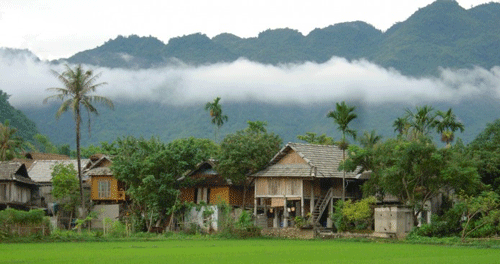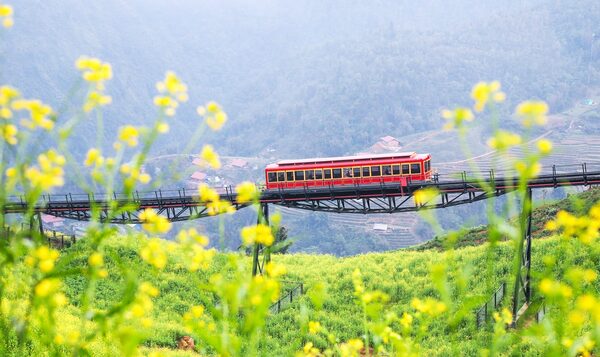Buddhism in Vietnam
Buddhism is probably the most popular religion in Vietnam and is mainly of the Mahayana tradition. Buddhism spread first from China to Vietnam’s Red River Delta region in approximately the second century A.D., and then from India to the southern Mekong Delta area at some time between the third and the sixth centuries. The most striking feature of Buddhism in Vietnam is the integration of Buddhist, Taoist and Confucian traditions. The religion reflects the rituals, beliefs and notions of all the three faiths in a balanced manner. The Chinese version, Mahayana Buddhism, became the faith of most Vietnamese, whereas the Indian version, Theravada Buddhism, was confined mostly to the southern delta region.
The period of Buddhist decadence continued till the time King Quang Trung came to power in the early 18th century. New Buddhist temples were built and the older ones were repaired to give Buddhism a new lease of life. But, before King Quang Trung could complete his task of restoring Buddhism, he died. Buddhism began to regain its lost glory by the onset of the 20th century. Today, influence of Buddhism in Vietnam is easily seen, however, the religion is still making efforts to enhance its influence on the life of the people.
Most beautiful pagodas in Vietnam
There are many famous and sacred Buddhism pagodas and temples in Vietnam that you should visit on you Vietnam Tours,. Here’s a recommended list of the most beautiful pagodas all over the country.
Pagodas in Northern Vietnam
1. One-Pillar Pagoda – Hanoi
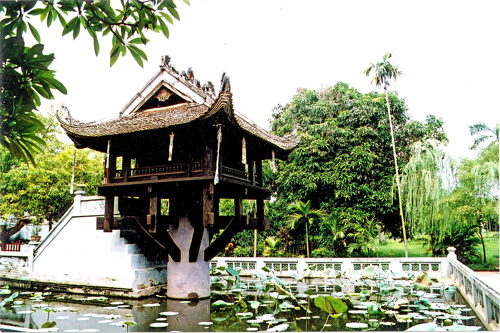
One-Pillar Pagoda is an iconic sight of Hanoi. This unique pagoda is a wooden structure built in 1049 by the Emperor Ly Thai Tong. The existing pagoda is a miniature reproduction of the original, which was said to represent a lotus emerging from the water. It is certainly interesting, and a prayer here is said to bring fertility and good health.
2. Perfume Pagoda – Hanoi
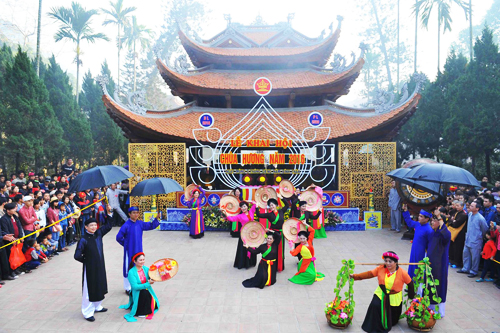
Perfume Pagoda is one of Hanoi’s most popular day tours. It is a vast complex of Buddhist temples and shrines built at the Huong Tich mountains in Ha Tay province. The center of this complex is the Perfume Temple, also known as Inner Temple, located in the Huong Tich Cave. Visitors need to take a boat trip to the base of the mountain, then hike on a small trail up or take a cable car to Huong Tich cave. This boat trip is one of the highlights of the trip to Perfume Pagoda.
3. Bai Dinh Pagoda – Ninh Binh
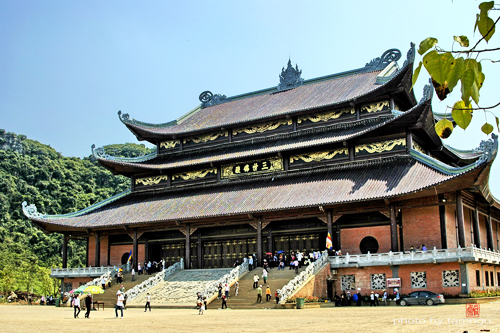
Bai Dinh Pagoda is the largest pagoda complex in Ninh Binh, about 95km to the South of Hanoi. The compound consists of the original old temple and a newly created larger temple. The old Bai Dinh pagoda is located in a cave on a small mountain near the new temple. The new one encompasses an area of 700 ha. This is a large complex which includes many structures built over several phases starting in 2003 and finally completed in 2010. Bai Dinh pagoda has become a popular site for Buddhist pilgrimages from across Vietnam.
4. Tran Quoc Pagoda – Hanoi
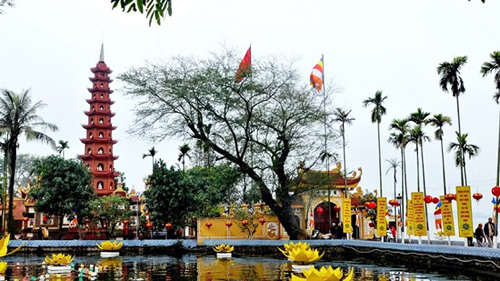
Tran Quoc Pagoda is the oldest of all Buddhist pagodas in Hanoi, located on a small peninsula on the eastern bank of Hanoi’s Westlake. It attracts thousands of people. During high season or special occasions like Tet Holidays, it will most likely be packed. Highlights include the Bodhi tree in the garden and its red lacquered Buddha statue.
Pagodas in Central Vietnam
5. Linh Ung Pagoda – Da Nang
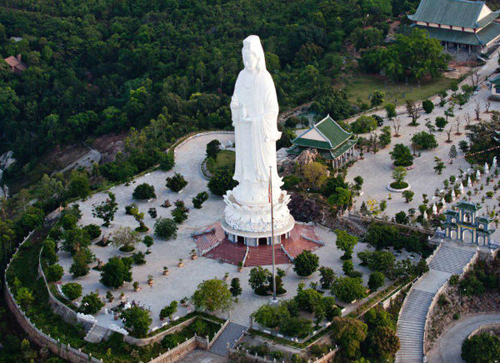
Located about eight kilometres from Da Nang, on a cliff off Son Thuy Moutain, Linh Ung is the largest pagoda in Da Nang in terms of scale and artistic architecture. The pagoda is famous for its beautiful 67-metre-tall Goddess of Mercy statue standing on a lotus-shaped platform. Thousands of visitors visit it to enjoy the panoramic view on the sea with the Marble Mountains in the back.
6. Thien Mu Pagoda – Hue
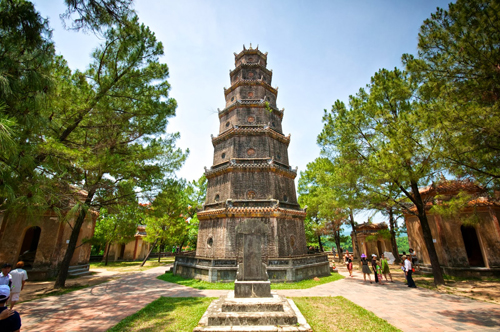
Thien Mu, meaning “Lady from Heaven,” is one of the top attractions in Hue. The Thien Mu pagoda was built in 1601 by Lord Nguyen Hoang. It sits on the northern bank of the Perfume River, around 3 km of the Citadel of Hue. Its stupa, Phuoc Duyen tower, has seven storeys and is the tallest in Vietnam. Thien Mu Pagoda is recommended to visit at sunset hours to experience the most beautiful and peaceful moments.
Pagodas in Southern Vietnam
7. Truc Lam Monastery – Da Lat
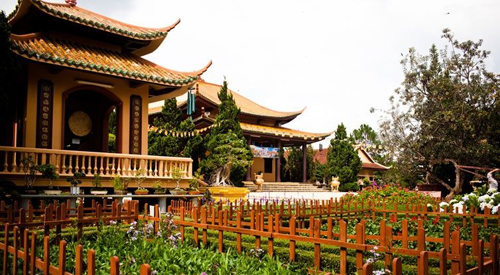
The Truc Lam monastery complex was completed in 1994 with the aim of giving new life to the Truc Lam Yen Tu Zen sect, a unique Vietnamese form of Zen founded during the Tran dynasty. With views of Tuyen Lam Lake and the surrounding mountains, the scenery around the Truc Lam monastery is breathtaking. It can now be reached by a scenic tram ride from a hilltop overlooking Dalat. If you want your trip to be adventurous, hire a motorbike or taxi to the tram station.
8. Giac Lam Pagoda – Ho Chi Minh city
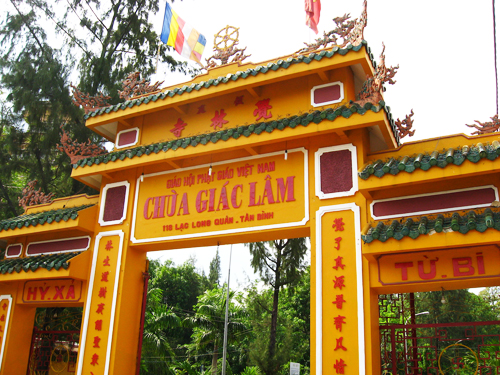
Giac Lam pagoda is one of the oldest pagodas in Ho Chi Minh city which was built in 1744. It’s undergone significant renovations twice, modernizing with the times each renovation. Despite its urban location, the first impressions about the pagoda are the expansive grounds that it sits on. One of the landmarks in the complex is a seven-story stupa that is accessible to visitors. You can climb up and get a nice view of the city.









